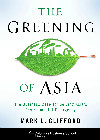Asia is fighting an environmental emergency.
The idea that Asia can follow the West’s ‘get dirty, get rich, get clean’ strategy grows more absurd with every year. Asian political leaders used to say that the region couldn’t afford the cost of environmental progress.
Now it’s clear that India and other countries cannot afford the skyrocketing cost of environmental degradation. Air pollution kills 1.2 million people a year prematurely in China alone, to take one among many examples.
Mark Clifford’s ground-breaking new book The Greening of Asia: The Business Case for Solving Asia’s Environmental Emergency, based on reporting from nine economies around the region, argues that businesses must be used more effectively to solve the crisis. Businesses have the money, the technology and above all the human ingenuity to turn challenges into opportunities.
This transition will only happen if governments lay down predictable long-term policies that include measurable short- and medium-term goals.
Prices – rather than regulations – should be used as much as possible. This reduces the opportunity for corruption and allows room for experimentation. Stripping away fossil fuel subsidies is a good place to start. Indeed getting rid of fossil fuel subsidies may prove even more important than subsidies to support wind and solar power.
Paradoxically, India’s shortages of water and electricity are spurring greater efficiency. India has long been a pioneer in green building. India’s businesses have built impressively energy-efficient buildings, using little electricity per person and artfully harvesting rainwater and making full use of water recycling. the U.S. Green Building Council recognized the CII Sohrabji Godrej Business Center in Hyderabad as the most energy efficient building of its kind in the world when it was built in 2003. Indian companies such as Godrej & Boyce, Infosys and many others have continued to build on this pioneering legacy.
Governments must set the rules. Much of Prime Minister Modi’s energy strategy consists of laudable forward-looking elements designed to take full advantage of India’s strengths. These include a desire to continue a dramatic increase in renewable capacity, especially solar power. The emphasis on using new technology, such as building small local micro grids rather than relying only on large central power stations and large-scale grid networks, is one way that India can leapfrog the old central-power-station model adopted by China and other more traditional economies. The agreement announced with President Barack Obama in January contained many positive elements. Increased funding by the U.S. for clean energy finance and continued bilateral research into clean energy technology is encouraging. The continued focus on coal, and the promise to double domestic coal production, is less welcome. Although Prime Minister Modi’s “all of the above” approach to meeting India’s energy needs is understandable, the coal sector’s many problems range from environmental ones to issues of governance and corruption. Coal more and more will be a technology of the past, an ugly reminder of the smoky industrial revolution a sign of backwardness.
India should consider re-doubling its efforts in new technologies, new ways of distribution and increased efficiency. With its technological and engineering skills and its ability to do more with less, India is well-positioned to take advantage of a new world in which vast increases in energy and electricity are provided in a more environmentally friendly fashion. Business is ready, willing and able. The clearer and more predictable ambiguous the signals from political leadership, the faster business can make this transition.
Clifford provides a behind-the-scenes look at what companies in China, India, Japan, Korea, the Philippines, Indonesia, Hong Kong, Singapore, and Thailand are doing to build businesses that will lessen the environmental impact of Asia’s extraordinary economic growth.
The Greening of Asia: The Business Case for Solving Asia’s Environmental Emergency, Mark Clifford, Columbia Business School Publishing, April 2015
This review was exclusively written for Gateway House: Indian Council on Global Relations. You can read more exclusive content here.
For interview requests with the author, or for permission to republish, please contact outreach@gatewayhouse.in.
© Copyright 2015 Gateway House: Indian Council on Global Relations. All rights reserved. Any unauthorized copying or reproduction is strictly prohibited.


